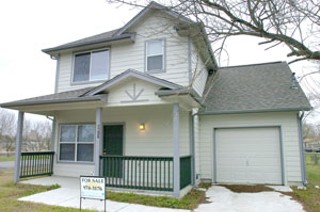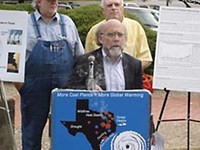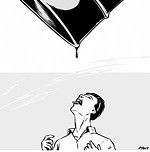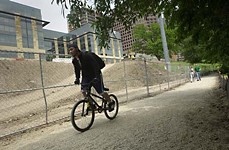Zero-Energy Homes and Hope Break Ground in Montopolis
The city shoots for energy efficiency and affordability in low-income neighborhood
By Daniel Mottola, Fri., Feb. 4, 2005

For the past three years, in a "laboratory" located on 13 acres of undeveloped land in Southeast Austin's Montopolis neighborhood, the city of Austin has been quietly making preparations for a large-scale experiment to study the design, construction, and feasibility of an affordable "zero-energy" home development. Groundbreaking is scheduled for some time this month, with construction utilizing solar panels and the latest in building technology – such that within a year, the homes are expected to produce more energy than they consume. The venture is a joint project of the Neighborhood Housing and Community Development Department, Austin Housing Finance Corp., and Austin Energy's Green Building Program, and the plan is to build up to 100 homes over the course of two years, in an otherwise impoverished neighborhood. In addition to demonstrating the effectiveness of zero-energy construction, another goal is promoting positive community growth through both affordability and sustainability.
As Texas cities continue to sprawl, conventional plans for supplying energy involve more coal facilities and more dependency on foreign fuels like liquified natural gas. By instead perfecting a local formula for cost-effective and streamlined "green" home-building, the city hopes both to promote practical methods of achieving major energy efficiency and, says GBP Project Manager Richard Morgan, "take steps to make small-scale, distributed energy part of Austin Energy's business plan." "We wanted to demonstrate to the public that the idea of a residential home producing all its own energy is within our grasp using current technology," added AE's Roger Duncan, who initiated plans for the development. Part of Duncan's job descript-ion as deputy general manager of Distributed Energy Services is to promote "distributed generation," or sustainable on-site energy production. He foresees electric utilities like AE evolving toward this style of small, decentralized energy generation.
The houses will produce electricity using roof-mounted solar panels. Other efficiency touches include extended roof overhangs, windows placed for minimal heat gain, and insulated roofs. Solar water heaters reduce gas consumption by 50-60%; the houses use gas only for cooking and supplemental water heating. Morgan figures overall energy use will be reduced by 50%, compared to a similar house built to code. As the home creates surplus energy, its electric meter runs backward, and energy is transmitted through power lines to other houses in the development that aren't making electricity at that time – and also back into AE's citywide grid. When the homes can't generate enough solar power on their own, they will draw electricity from the grid.
Yet, no matter how much utility savings the homes may create, the true test in standardizing a successful green development prototype is affordable, inclusive pricing, especially in low-income Montopolis. "It's a very strong community with so much integrity in the neighborhoods," said AHFC spokesperson Julie Beggs. "We made a major movement to listen to what neighbors wanted: no more rentals." Montopolis Neighborhood Alliance President Brad Joyner agrees. "We are overburdened with subsidized apartments that turn into slums in 10 to 12 years," said Joyner. "We need a healthy mix of single-family, duplex, and triplex homes with businesses to serve the neighborhood."
A primary goal is to make the homes available to families earning 80% or less of the area median family income, or $56,500 a year. The appraised value for each home, including land, should fall into the $80,000-120,000 range. "We hope to create 85 home ownership opportunities in places where people grew up, have family, or go to church, without displacing people out of the city … and while being energy efficient," said Morgan, adding that he hopes eventually to make similar homes available to people earning below 50% of the median income.
The zero-energy homes adhere closely to two sets of guidelines: the city's S.M.A.R.T. Housing initiative – Safe, Mixed Income, Accessible, Reasonably Priced, and Transit-Oriented development – and the existing Montopolis neighborhood plan. The look of the homes, prescribed by the plan's design standards, is traditional, with big front porches, gables, and front-facing entries.
But one important area of the neighborhood plan the development doesn't directly address, says Joyner, is bringing business-related vitality into the area. Commercial land has been designated in the neighborhood plan, because people want stores closer than the six to seven miles some residents now have to travel, and because new stores also mean new jobs. "It's still a tough neighborhood, my friend," Joyner said. "We have a hard time with drugs, drive-bys, and feeding people that have nothing." A combination of owner-occupied homes and small businesses, Joyner believes, would help the neighborhood get healthy. With 85 to 100 homes slated for construction, the hope is that businesses and prosperity will follow the influx of new residents, making the development a triumph on all counts.
Got something to say on the subject? Send a letter to the editor.










